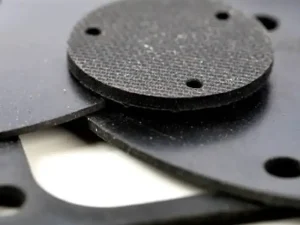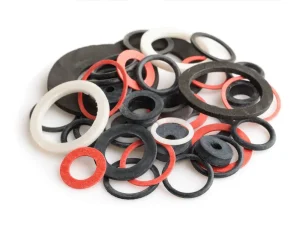Rubber gaskets play an essential function in a variety of applications. You know, they can have various forms and compositions. The only reason for this diversity is to meet the specific requirements of various applications. Assume you have a project that requires the use of chemicals. So, you’ll need a rubber that can endure those chemicals. In such situations, a nitrile and neoprene gasket is the ideal option. The neoprene seal is also famous for weatherstripping, sealing, hose covering, and many more.
Neoprene gasket seals typically form a tight seal between two or more mating surfaces. We can observe their performance in a variety of applications. I think we should consider an example. You can check out your door jams. There are some rubber seals installed around it, right? Do you know what these rubber gasket seals are used for? They provide weather protection and, regulate room temperature & reduce noise. Similarly, we can see the application of neoprene gasket seals in various machinery. These rubber products aim to offer sealing, cushioning, vibration reduction, and shock absorption.
This article explains the differences between a neoprene gasket and various rubber gaskets. To learn more about neoprene rubber seals, check out the article “Neoprene rubber seal ultimate guide.”
What Is a Neoprene Gasket?

Neoprene rubber was first developed by DuPont Company in 1930. There’s an interesting fact about the name of this rubber. The name comes from two Greek words, “neo” & “prene,” meaning new rubber. The composition of neoprene rubber is typically a polymerized chloroprene. The polymerization process involves adding curing agents, such as sulfur or peroxide. Let’s explore some popular neoprene rubber gasket products.
- Neoprene Seal Strips are extremely popular in many industries. They have vast applications in the construction, chemical, automotive, and marine industries.
- Neoprene Gaskets play a crucial role in many mechanical machinery. They provide excellent cushioning, vibration reduction, and shock absorption.
- Neoprene Gasket Sheet is widely used in roofing and flooring applications. It is famous for noise isolation in power transformers and as an adhesive foundation.
- Neoprene Rubber Washers are great for making watertight seals for oils & petrochemicals. In addition, they don’t degrade at high or cold temperatures. Consequently, they harden and keep the seal impermeable under stress.
Do you know why the neoprene rubber seal is so popular? It is because of its chemical and weather resistance. Neoprene is known for its resistance to weather, chemicals, and UV radiation. Besides, it can withstand high temperatures without breaking down. Oh! It is also flexible and elastic, like EPDM rubber seals. Overall, neoprene rubber is an excellent choice for all-purpose activities.
Neoprene Gasket Vs Rubber Gasket

Regarding neoprene gasket vs. rubber gasket, each material brings its unique properties to the table. Both natural and neoprene gaskets are excellent because they offer flexibility and durability. However, they differ when compared to other parameters such as temperature, oil resistance, and applications.
You know, neoprene is a synthetic rubber. So, naturally, it offers a broader temperature range compared to natural rubber. Conversely, natural rubber is derived from the latex of rubber trees. So, it naturally provides more flexibility than neoprene seals and gaskets. However, there are other things to consider when deciding between these two rubber materials. We need to find ways to make our investments more productive. Let’s look at the summary table comparing neoprene and rubber gaskets.
| Characteristics | Neoprene Gasket | Natural Rubber Gasket |
| Material Composition | They are made from polymerized chloroprene. | They come from latex derived from rubber trees. |
| Resistance to Oil & Grease | Neoprene gasket materials are prevalent for this resistance ability. | Offers limited oil resistance |
| Temperature Tolerance | -45F to 260F Neoprene rubber gaskets are suitable for use in high and low-temperature applications. | -67° F to +180° F Natural rubber may not be suitable for high-temperature applications |
| Cost | Neoprene rubber is relatively more expensive than natural rubber | Natural rubber offers the most economical solutions. |
| Durability | Excellent durability in outdoor situations | Durable but has limited resistance to oil and chemicals & may degrade over time. |
| Resistance of ozone and oxidations | High resistance | Limited resistance |
| Resistance to strong acid | Poor resistance | Limited resistance ability |
| Applications | Automotive, industrial, and marine applications | General-purpose applications, non-oil applications |
Neoprene Gasket Vs EPDM Rubber Gasket
Neoprene and EPDM rubber gaskets are made from different synthetic rubbers. In general, both rubbers have wider temperature ranges. Although EPDM outperforms neoprene. EPDM rubber seals are better for high-temperature applications. You can also use a neoprene gasket for high-temperature applications. But it would be best if you considered each rubber material’s limit.
In the chemical industry, neoprene and nitrile rubber are the best solutions. EPDM rubber seals are ideal for weather stripping and other sealing applications. However, neoprene rubber is also suitable for outdoor applications. In addition, the neoprene rubber seal is more flame-resistant.
| Characteristics | Neoprene Gasket | EPDM Rubber Gasket |
| Material Composition | Polymerized Chloroprene | Ethylene Propylene Diene Monomer |
| Temperature Range | -45F to 260F Neoprene gasket offers a lesser temperature range than EPDM | -60°F to +300°F EPDM rubber offers a broader temperature range than Neoprene rubber |
| Flame Resistance | Compared to EPDM, neoprene rubber gaskets offer more resistance to heat and flame. | Less resistance than Neoprene Rubber seals |
| Flexibility | Moderate flexibility, suitable for limited applications | Excellent flexibility, ideal for many applications where adapting contours & shapes is essential |
| Weather Resistance | Resistance to ozone, sunlight, and adverse weather conditions | Exceptional resistance to weather, UV, and ozone |
| Oil and gas resistance | Excellent oil and gas-resistant | Less resistant than neoprene rubber gasket material |
| Cost | Normally more affordable than EPDM | Often more expensive than neoprene |
Neoprene Vs NBR Rubber Gasket

Neoprene and NBR are both synthetic rubber, although their material composition differs. Both of these rubbers offer similar temperature ranges. As a result, you can find them relatively high-temperature applications. Although, for extreme temperatures, EPDM is still the best solution.
The primary difference between Neoprene and NBR rubber is their applications. A neoprene rubber gasket is suitable for both indoor and outdoor applications. On the other hand, NBR may not be ideal for outdoor applications because, over time, it degrades under sunlight. However, you may often find NBR in oil and fuel industry applications. Let’s take a look at their fundamental differences in the following table.
| Characteristics | Neoprene Gasket | NBR or Nitrile Gasket |
| Material Composition | Polymerized Chloroprene | Nitrile Butadiene Rubber (NBR) |
| Temperature range | -45F to 260F Suitable for high-temperature applications | -40°F to 257°F It is also suitable for high-temperature applications |
| Flexibility | Good flexibility | More flexible than neoprene |
| Oil Resistance | Excellent | Excellent |
| Weather resistance | Excellent resistance to ozone, sunlight, and diverse weather conditions | Moderate resistance to weathering, less resistance to sunlight |
| Application | Suitable for outdoor applications, gaskets and seals | Suitable for use in oil and fuel industry applications, seals, O-rings in machinery |
| Cost | More affordable than NBR | More expensive than neoprene |
Frequently Asked Questions
Q1. What Is So Special about Neoprene?
Neoprene is a specialized rubber material when compared to natural rubber. It resists solvents, oil, water, heat, oxygen, and ozone. The exciting thing about neoprene rubber is that it is ideal for indoor and outdoor applications. It is good against weather & sunlight. So you will only need to replace them sometimes.
Q2. Is Neoprene Rubber Better Than Rubber?
Considering the overall performance, neoprene rubber is undoubtedly superior to natural rubber. It offers a better temperature range and resistance to weather, ozone, and various solvents. We may not get this from natural rubber. However, considering the budget and flexibility, natural rubber is superior to neoprene rubber. So, choose EPDM or neoprene if your project involves outdoor activity. Also, they are ideal for varying operating temperatures.
Q3. Is Neoprene Rubber Or Plastic?
Neoprene is a synthetic rubber, not plastic. It is a type of polymer made through a process called polymerization.
Q4. Is Neoprene Rubber Better Than Silicone?
Neoprene is generally chemically resistant (but not for strong acids or bases). It makes them an excellent choice for protecting against solvents and greases. You can also use ethyl alcohols, mineral acids, and salt solutions. However, silicone does not fare well in terms of resistance to oils, solvents, and other chemical variables.
Q5. Can Neoprene Rubber Withstand Heat?
Yes, it can work in the temperature range between -45F to 260F. However, neoprene was made for its various oils and chemical-resistant properties. It also can withstand specific temperature ranges. One of the primary benefits of neoprene rubber is its flame-resistant ability. You may find neoprene dealing with fire door seals and firefighter suspenders.
Expert Advice
We are now at the end of our today’s discussion. We have studied fundamental differences between neoprene rubber gaskets and other rubber materials. So, this discussion typically highlighted the suitability of neoprene rubber in different applications. It compared other rubber materials with neoprene to find the most appropriate choice. Now, choosing a suitable rubber material for your project becomes easy. All you need to do is to consider a few factors before purchasing it. Let’s check what they are.
- Application Requirements: First, you must be clear about your project requirements. What is its purpose? What are the possible operating temperature ranges? Is it involving chemicals, solvents, or gases? Does it require flexibility?
- Material Properties: You can then compare the requirements with the rubber material properties. You can check for stress, flexibility, ability to withstand temperature, and weather resistance.
- Compatibility: The rubber material must be compatible with the specific project. Let’s say your project requires outdoor applications. In this case, neoprene and EPDM are the best choice.
- Quality Standard: These documentation and certifications are necessary to trust a manufacturer. Check if your chosen neoprene gasket manufacturer offers various national and international standards.
- Budget: Finally, you can consider your budget and choose the most productive choice for your project.
Above all, if you have any questions regarding different rubber materials, please get in touch with us. We have a team of experts who can answer all your questions quickly. However, we hope this article can help you find the right product. Stay tuned and learn more essential knowledge about rubber products and their uses.
